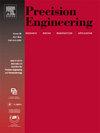Fast and affordable printing of polymeric nanostructures via superluminescent light projection
IF 3.5
2区 工程技术
Q2 ENGINEERING, MANUFACTURING
Precision Engineering-Journal of the International Societies for Precision Engineering and Nanotechnology
Pub Date : 2025-01-22
DOI:10.1016/j.precisioneng.2025.01.016
引用次数: 0
Abstract
The ability to additively manufacture polymeric nanostructures is highly desirable, but existing light-based techniques are challenging to scale up due to the need to engineer optical nonlinearity into the process. This nonlinearity enables overcoming the optical diffraction limit so that nanoscale features that are smaller than the focused light spot can be printed. However, achieving optical nonlinearity requires either expensive high-intensity femtosecond lasers to activate multi-photon absorption or novel custom-designed photoresists to activate multi-step absorption. Here, we present the superluminescent light projection (SLP) technique as an alternative approach that does not require one to engineer optical nonlinearity into the process, yet it is still capable of sub-diffraction printing. We achieved this by digitally patterning a low-intensity light beam generated from a low-cost superluminescent diode and projecting the patterned beam into a UV-curable photoresist. SLP can print features as small as 325 nm with 405 nm light and at an intensity of 36 W/cm2, which is more than 25 billion times lower than that required for multi-photon 3D printing. Furthermore, it enables rapid printing of 3D structures through its layer-by-layer writing mechanism at a voxel generation rate of up to 2.3 × 105 voxels/s using a system which is 35 times less expensive than multi-photon printers. Thus, SLP can significantly advance the affordability of rapid nanoscale 3D printing for a variety of applications.

通过超发光光投射快速和负担得起的聚合物纳米结构印刷
增材制造聚合物纳米结构的能力是非常可取的,但是由于需要在过程中设计光学非线性,现有的基于光的技术在扩大规模方面具有挑战性。这种非线性可以克服光学衍射极限,从而可以打印出比聚焦光斑更小的纳米级特征。然而,实现光学非线性需要昂贵的高强度飞秒激光器来激活多光子吸收或新型定制设计的光阻剂来激活多步吸收。在这里,我们提出了超发光光投影(SLP)技术作为一种替代方法,不需要在过程中设计光学非线性,但它仍然能够进行亚衍射印刷。我们通过对低成本超发光二极管产生的低强度光束进行数字图案化,并将图案化的光束投射到紫外线固化光刻胶中,从而实现了这一目标。SLP可以在405 nm光下打印小至325 nm的特征,强度为36 W/cm2,比多光子3D打印所需的强度低250亿倍以上。此外,它可以通过其逐层写入机制以高达2.3 × 105体素/s的体素生成速率快速打印3D结构,使用比多光子打印机便宜35倍的系统。因此,SLP可以显著提高各种应用的快速纳米级3D打印的可负担性。
本文章由计算机程序翻译,如有差异,请以英文原文为准。
求助全文
约1分钟内获得全文
求助全文
来源期刊
CiteScore
7.40
自引率
5.60%
发文量
177
审稿时长
46 days
期刊介绍:
Precision Engineering - Journal of the International Societies for Precision Engineering and Nanotechnology is devoted to the multidisciplinary study and practice of high accuracy engineering, metrology, and manufacturing. The journal takes an integrated approach to all subjects related to research, design, manufacture, performance validation, and application of high precision machines, instruments, and components, including fundamental and applied research and development in manufacturing processes, fabrication technology, and advanced measurement science. The scope includes precision-engineered systems and supporting metrology over the full range of length scales, from atom-based nanotechnology and advanced lithographic technology to large-scale systems, including optical and radio telescopes and macrometrology.

 求助内容:
求助内容: 应助结果提醒方式:
应助结果提醒方式:


